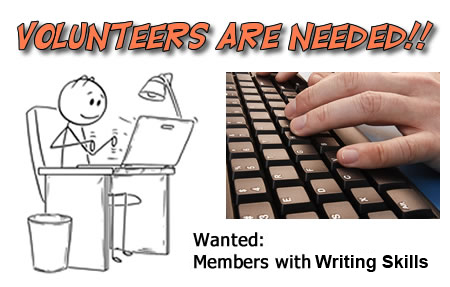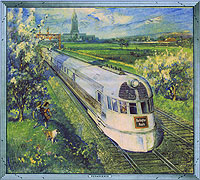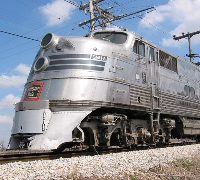|
|
| Submission Guidelines for the Bulletin & Zephyr |
| General Information - The society's two publications depend upon its readers for most of the photos and words we publish. We can't promise acceptance, of course, for even the best of photos or text may duplicate material already on file or assigned or may exceed our space limitations. But we do look at each print and color slide submitted, and we do read, as time permits, every story. If you have an idea for an article, run it by us and let us know what materials you must tell the story. We can then see if someone else has any of the missing pieces so that a complete article can be pulled together. That is how we can all help make this work. If you already have an idea and want it published in the There is specific submission guidelines for different types of material: |
- Slides and Photographs
- Articles
- How-to Modeling Articles
|
| Payment - The Burlington Route Historical Society does not pay for articles or photographs that appear in the Burlington Bulletin, or the Society's Zephyr newsletter. When sending material via the USPS provide an appropriately-sized, stamped, self-addressed envelope for its return in the event we cannot use it. |
| |
Slide & Photographs Guidelines - The preferred formats for images used in both publications are 35mm slides, negatives or 8x10-inch glossy black-and-white or color prints. If you have the slide or negative, please send that instead of a print. Do not send negatives or prints larger than 11x17 inches. If you wish to send transparencies in other formats, e.g., 2 1/4 x 2 1/4-inches or 4x5-inches,
e-mail Editor@BurlingtonRoute.org prior to sending them.
- Slide or Negative Format - At the present time, we can accept original slides or negatives in 35mm as well as 2 1/4 x 2 1/4-inch or 4x5-inch transparencies. Please contact us before you send anything. Slides will not be dismounted during the scanning process.
- Scans - If you wish, you can scan your images and send the scans on a CD, DVD, USB or other SD memory media. Files must be saved as uncompressed TIFs. Prints should be scanned at 600dpi or higher. Slides and negatives should be scanned at the maximum optical capability of your scanner. Do not manipulate the scanned image in any way except to adjust its orientation. We will adjust color, contrast, sharpness, etc.
- Captions - Each slide mount or print must have the photographer's name and address on it and a unique, identifying number. Should it become separated from other material submitted with it we can return it and the number will correspond to the captioning information submitted separately. Do not type or write on the print, and do not use rubber cement. If adding caption material to the back of prints, please use so-called magic transparent (matte finish) tape, post-it notes or self-adhesive labels. Prints and slides should have as much information as possible (location, date, subject). Expanded information for slides should accompany them on a separate sheet with each image's identifying number.
- Photo Credits - If the image was not taken by you, the BRHS assumes you have permission to provide it and we MUST have the proper credits for publication.
- Return - We normally return slides and prints unless you indicate that you do not want them returned. Be sure to include your complete mailing address (and e-mail address) on all slides and prints.
|
|
|
| “How To” Guidelines |
| |
| The modeling how-to article you submit should include the following items: |
- Text - Tell how you did the project, or tell the reader how to do it, in simple, clear, and direct language. Use photos and drawings extensively, and put details, dimensions, and part numbers in the illustrations. Use active description or instruction, such as "I painted the roof black" or "Paint the roof black," and avoid the passive, "The roof was painted black."
- Lead photograph - Show the model or project at its best, to get the reader's attention and encourage him to read and follow the article. Usually it's best to show the subject of the article in a finished model scene, with the photo composed so the article subject is the dominant element. Alternately, show the subject against a plain, untextured backdrop of a neutral color—seamless photo backdrop paper is ideal.
- How-to illustrations - Use drawings and photos to show the project under construction. Number each as a figure, i.e., fig. 3, and refer to them by the corresponding number in the text. Neat, legible pencil drawings are acceptable, as our art staff will prepare finished ink drawings for publication. Drawings need not be to scale unless scale is important, as with exact-size templates, for example. How-to photos should generally be taken against plain backgrounds. You may include callouts--labels with pointers--in a black-and-white photo: make a photocopy of the print and write and draw on the copy.
- Bill of materials - Give a detailed list of items needed to build the project. Include manufacturers' names, part numbers, part names or descriptions, and quantities required. Be sure your information is current. Explain if the reader will have to substitute for items which are no longer available. If you doubt that the reader will know where to find some item, include the manufacturer's address.
- Prototype information (where applicable) - Use photos and/or drawings to show the reader the prototype you followed. Photos may be color, black-and-white, or both.
|
| |
| If you have any questions regarding these guidelines for submission, please contact Editor@BurlingtonRoute.org |
 |
|
|
| Editor Mailing Address: |
BRHS Editor, David Lotz
113 Magnolia Drive
Pooler, GA 31322
|
|
|
| Membership Mailing Address: |
BRHS Membership Services
P.O. Box 456
La Grange, IL 60525 |
|
|


